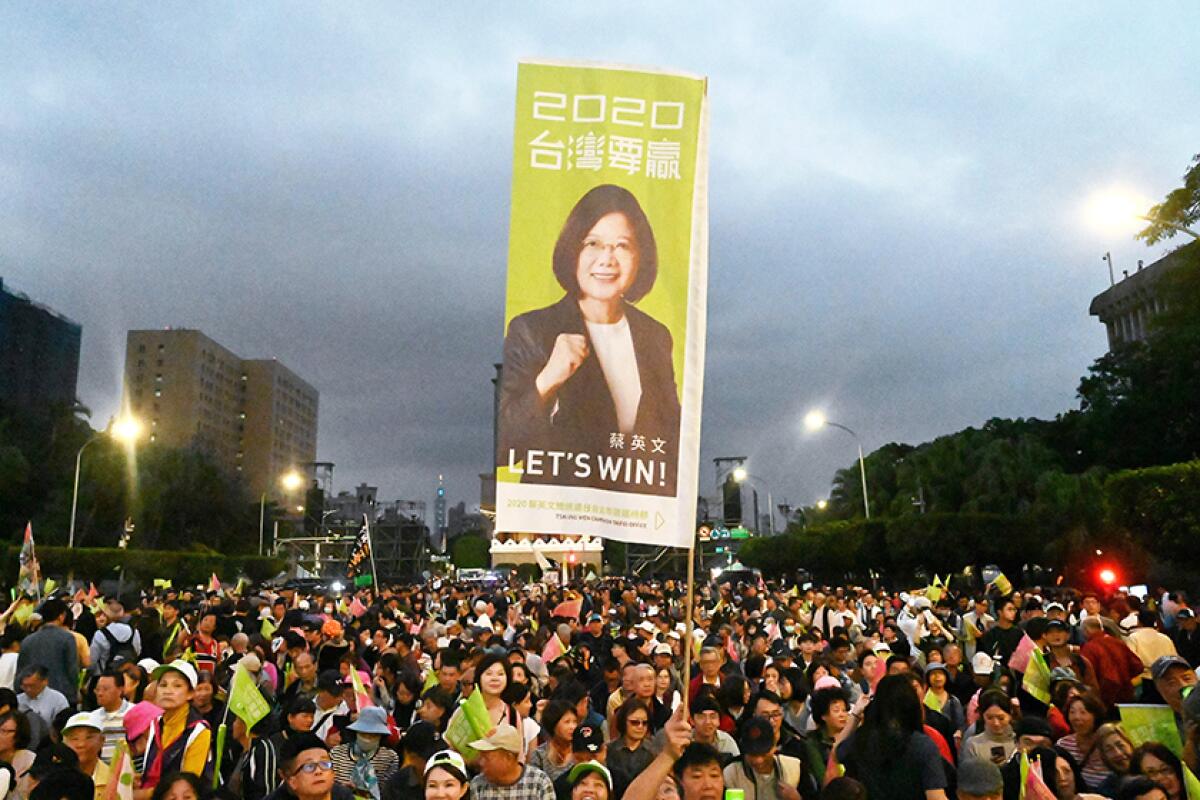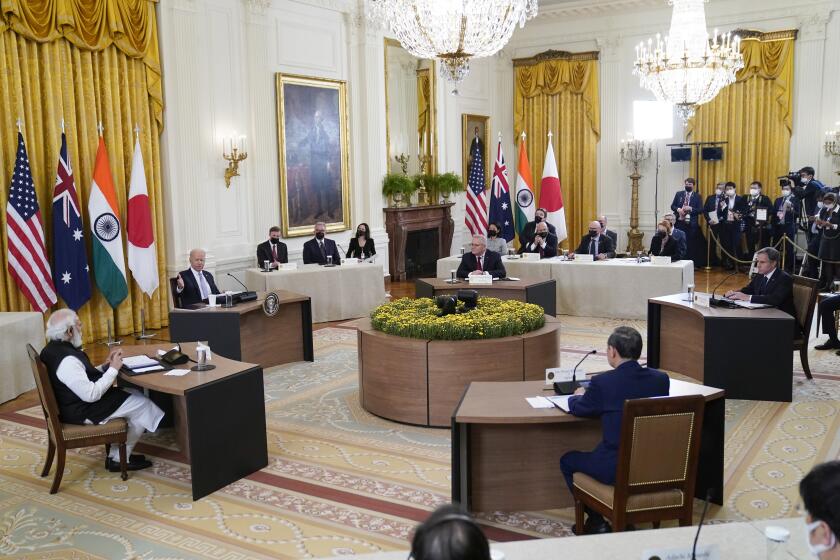Op-Ed: The U.S. is caught in a foreign policy triangle over Taiwan. Here’s how to solve it

- Share via
The relationship between the United States and China promises to do much to define this era. And what could determine this relationship might well be whether the two countries are able to continue to avoid armed conflict over Taiwan. But with signs of potential conflict growing, the question facing the U.S. and its partners is how to avoid that outcome without sacrificing essential interests.
Conceptual framing is always critical to foreign policy. There are problems and there are situations. Problems can in principle be solved. Situations can at best be managed. Taiwan is a situation. Attempts to treat it as a solvable problem will not just fail but most likely result in a conflict that will leave the U.S., Taiwan, China and others in the region and the world much worse off. The reason is that there is no possible outcome that would be universally acceptable.
But the diplomatic framework that the United States and China put in place four decades ago — in which the two sides essentially agreed to disagree over Taiwan — allowed them to avoid conflict and build a productive relationship that helped end the Cold War peacefully and on Western terms. The U.S. and China went on to develop a deep economic relationship. Taiwan, for its part, became one of Asia’s tigers and evolved from a one-party dictatorship into a robust democracy.
U.S.-China relations have deteriorated sharply in recent years, but not because of Taiwan. Instead, these factors are to blame: China’s militarization of the South China Sea, its unfair trade practices, its growing repression at home and its economic coercion of countries in the region.
Now there is speculation that Chinese President Xi Jinping is contemplating the use of force to absorb Taiwan to realize his goal of China’s “rejuvenation” and build his legacy. He may also be trying to shape Taiwan’s politics and strengthen leaders it perceives as being friendlier to the mainland. Whatever Xi’s motives, we have seen increased economic pressure on Taiwan, cyberattacks, attempts to sow disinformation and interfere in its democracy, military flights near the island, the deployment of additional military capabilities along China’s coast near Taiwan and efforts to keep Taiwan out of international organizations.
The Biden administration is building a Cold War-style web of alliances to contain China. Will China strike back?
Official U.S. policy has long emphasized that if the status quo is to change, it must be done consensually and with the support of the people of Taiwan. The United States has also consistently stated it does not support Taiwan’s independence, in an effort to prevent Taiwan from triggering a crisis.
Some in the U.S. advocate accepting what they see as the inevitability of the mainland’s takeover of Taiwan. But allowing China to coerce or absorb Taiwan would undermine or even end the U.S. alliance system in Asia. Governments would either be inclined to defer to China — an Asian version of Finlandization — or become more autonomous, which could lead to conventional military and even nuclear proliferation.
In addition, nearly 24 million Taiwanese residents would see their democracy extinguished, while China would be able to project power throughout the Pacific and dominate Taiwan’s vital semiconductor industry. Any of these outcomes would reduce regional stability, freedom and prosperity.
Others believe that Taiwan is a country in all but name and ought to be treated as one. But encouraging or recognizing Taiwan’s independence in the face of mainland opposition would almost certainly result in conflict, a rupture in U.S.-Chinese relations, or both.
This means continuing to make clear to Taiwan that it must act with caution. Some argue that this gives China too much influence. But a successful foreign policy often requires tough tradeoffs. To avoid the prospect of war and maintain a working relationship with the world’s second-largest economy — a global power in a position to shape outcomes on issues such as climate change, world health and nonproliferation — the U.S. does not have a free hand with Taiwan.
What is needed are policy changes appropriate to dealing with a more capable and assertive China. That includes enhancing U.S. military capabilities in the region, building closer defense integration with Japan and Australia, strengthening Taiwan’s defense capacities most relevant to slowing a Chinese invasion, and coordinating with partners and allies in the region and Europe on economic and military measures that would be taken in response to Chinese aggression.
Some of this should be communicated to China; the goal should be to reduce uncertainty about America’s intentions and its ability to make good on them, while underscoring to Chinese leaders the economic and military costs of aggression. A declaration by Congress granting the president conditional authority to use military force in response to Chinese aggression against Taiwan should also be considered.
At the same time, President Biden’s administration should make clear that it is not departing from America’s longstanding “one China policy” that acknowledges Taiwan as part of China. Accordingly, it “recognizes the government of the People’s Republic of China as the sole legal government of China,” maintains unofficial relations with Taiwan, and holds that any change must not come about from the threat or use of force.
As much as China’s leaders want Taiwan, they also want to maintain power and the Communist Party’s political monopoly. A costly war of choice to conquer Taiwan could jeopardize this.
But if Taiwan were to declare independence, or the U.S. were to recognize Taiwan as sovereign, many on the mainland would view an invasion of the island as a war of necessity. The goal of U.S. policy should be to deter the former and avoid the latter.
Richard Haass, president of the Council on Foreign Relations, is the author, most recently, of “The World: A Brief Introduction.”
More to Read
A cure for the common opinion
Get thought-provoking perspectives with our weekly newsletter.
You may occasionally receive promotional content from the Los Angeles Times.











